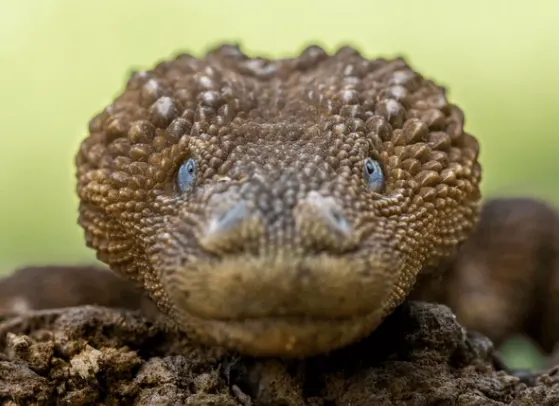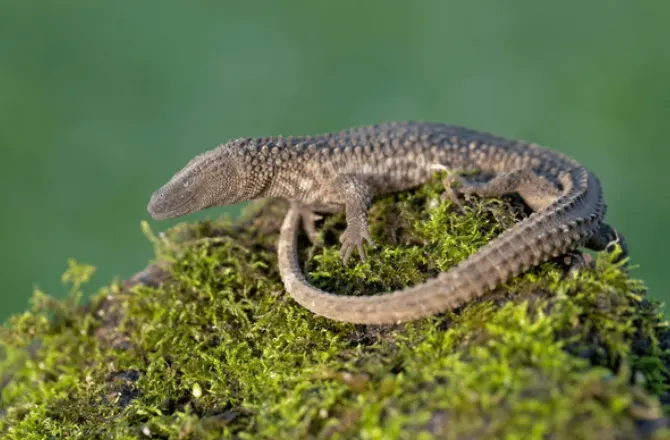The Earless Monitor Lizard, scientifically known as Lanthanotus borneensis, is one of the rarest and most fascinating reptiles on the planet. Native only to the island of Borneo, this unique creature has captured the attention of scientists and reptile enthusiasts for over a century.

Let’s take a closer look at this mysterious lizard, exploring its unique features, habitat, and the conservation challenges it faces.
Table of Contents
1. A Lizard Like No Other
Imagine a lizard that lacks external ears but can still hear perfectly. This is the reality of the earless monitor lizard. Despite having no visible ear parts, this lizard is well-adapted to its environment, relying on other senses for survival.
Key Physical Features:
- Length: About 16 inches
- Weight: Up to 4 ounces
- Color: Brownish-orange with a lighter underside
- Bumpy Scales: Similar to the Gila monster, these scales help it camouflage in muddy environments.
- Tiny Limbs: This lizard’s legs are small and weak, making it move more like a snake than a typical lizard.
2. A Master of Camouflage and Stealth
The earless monitor lizard is not just physically unique, but its behavior sets it apart from many other reptiles.
Survival Tactics:
- Camouflage: Its rough, bumpy scales cling to mud, helping it blend seamlessly into its environment.
- Stillness: These lizards can slow down their metabolism, becoming almost comatose for extended periods. This allows them to survive long periods without
food or water. - Night Hunter: Being nocturnal, the earless monitor lizard hunts mainly at night, feeding on crustaceans, fish, and small frogs.
In the wild, you’d be lucky to catch a glimpse of this elusive lizard as it hides among the muddy banks of lowland streams.
3. The Hidden Lizard of Borneo
Borneo is home to countless unique species, but few are as elusive as the earless monitor lizard. This reptile is found only in the northwestern coastal region of Borneo, primarily near Niah National Park. Unfortunately, due to habitat destruction, their population is shrinking rapidly.
A Snapshot of Borneo’s Habitat:
- Rainforests: Lush and dense, Borneo’s rainforests are teeming with wildlife.
- Streams and Rivers: The earless monitor prefers habitats close to water, where it can hunt and camouflage.
4. Conservation Status: Endangered
Since 2019, the earless monitor lizard has been classified as endangered by the IUCN. This rare species faces two major threats:
- Illegal Pet Trade: The demand for rare species has led to a surge in poaching. The earless monitor is often sold for thousands of dollars on the black market.
- Habitat Destruction: As deforestation continues in Borneo, the lizard’s natural habitat is disappearing, further pushing this species towards extinction.
5. Incredible Facts About the Earless Monitor Lizard
Here are some fascinating insights into the world of the earless monitor lizard:
- “Coma Mode”: These lizards can shut down their metabolism to a near-comatose state, enabling them to survive extreme conditions.
- Hard to Find: In the 100 years after its discovery, fewer than a dozen specimens were found in the wild.
- Venomous: Recent research revealed that the earless monitor has venomous glands, similar to its distant relatives, the Gila monster and beaded lizard.
6. A Glimpse into its Evolution
The earless monitor lizard is a living fossil, tracing its evolutionary roots back 90 million years. Over time, it adapted to its aquatic environment, becoming a master swimmer and expert hunter. Despite being related to monitor lizards like the Komodo dragon, the earless monitor has carved out its own evolutionary path, standing alone in its own family, Lanthanotidae.
7. Reproduction and Lifespan
Little is known about the reproductive habits of the earless monitor lizard in the wild, but scientists have made some discoveries through the study of captive specimens.
Reproduction Facts:
- Gestation Period: Around 130 days.
- Clutch Size: Typically, females lay about 4 to 6 eggs.
- Incubation Period: 70 to 80 days.
- Mating Behavior: Males are larger than females, particularly around the base of the tail, and can be identified by their wider heads.
Due to the lizard’s elusive nature, its lifespan remains a mystery, though it is believed to live for many years.

8. The Future of the Earless Monitor Lizard
With its endangered status and increasing threats from habitat loss and illegal trading, the future of the earless monitor lizard looks uncertain. Conservation efforts, including protection under CITES (the Convention on International Trade in Endangered Species), are vital for ensuring that this rare reptile continues to survive.
How You Can Help:
- Raise Awareness: Sharing information about the earless monitor lizard can help reduce illegal trade.
- Support Conservation Efforts: Donating to wildlife organizations focused on protecting endangered species can make a difference.
The earless monitor lizard is a true testament to nature’s ability to adapt and survive. From its venomous bite to its remarkable camouflage, this small yet mighty reptile deserves our admiration and protection. As we learn more about this fascinating species, we must also take action to preserve its place in the world.
- Enchi Ball Python: A Unique and Stunning Morph of Python regius - March 27, 2025
- Emerald Tree Monitor: The Enigmatic Green Guardian of the Rainforest - March 26, 2025
- The Egyptian Cobra (Naja haje): A Fascinating Serpent - March 25, 2025
